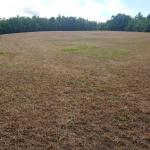As most turf managers are aware, unusually high activity of armyworms has been documented in some areas of the United States for the past several weeks. Armyworms and fall armyworms have been infesting and destroying lawns across the Midwest and Southern states and up the Eastern seaboard to the Chesapeake Bay area, but activity and damage in the Northeast has not been as widespread. More recently, however, we have received several reports of armyworm egg masses and hatching larvae, especially on the flags at golf courses (Fig 1-3). Most of the egg masses were observed in in Connecticut, Western and Eastern Massachusetts during last two weeks. Panic is discouraged, as this wave of armyworm activity is very late in the season, is not very common for our region, and it is questionable whether the hatching larvae will be able to reach later instars and cause significant damage by the time temperatures cool down.
Armyworms cannot survive winter in New England and usually are not a perennial problem, but nevertheless there is an occasional outbreak every 20 to 30 years. When they are in the area, armyworms often come in high numbers and their feeding can cause devastation in a very short time. We observed an infestation of the common armyworm in a pasture in September 2020 (Figs 3-4). According to current reports from other states, lawns and golf course turf have been at great risk this year. Because it is the end of the season, we only expect one generation of the armyworm at any affected area in Southern New England, which is typical for armyworm populations in this region.
Life cycle
Adults are relatively large moths (~1” wing span) which live for 1-2 weeks and migrate, often brought to New England by weather fronts, storms and hurricanes from Southern regions. The forewings have a dull gray color with white markings; hind wings are off-white with darker edges. The inconspicuous coloration is usually the reason why these moths remain undetected. Each female lays about 1000 eggs in a lifetime. Egg masses can be found on structures above the ground, such as poles, walls, fences, leaf undersides, and very commonly on golf course flags. Each egg mass has about 400 eggs stuck in up to 4 layers and covered with the female’s abdominal hairs (Fig 2).
When hatched, small larvae produce a silk thread and disperse from the egg deposition site to turf by wind, “ballooning” to the host plants. When larvae are small, they and their feeding are hard to notice, they barely cause any damage. Small caterpillars skeletonize or scrape the grass blade surface. Large larvae, however, can cause significant damage in very short time. The larval development takes about 2-3 weeks (from the eggs to the fully-grown last instar). Large caterpillars have a very dark blue or black base color, light beige stripes along the side of the body, dark spots at the base of the prolegs, and a two-toned light and dark brown head capsule. The caterpillars feed mostly at night and consume above ground grass tissues, which exposes crowns to sun and drought, often resulting in plant death. Because armyworms occur in large numbers, birds are attracted to the infested areas. Heavy bird feeding can be an additional sign of armyworm infestations.
Hosts
Armyworms feed on variety of crops, but especially prefer crops in the grass family (Poaceae or Gramineae), for instance, corn, wheat, rice, etc. They can feed on most warm and cool season turfgrasses. In New England fescues, ryegrass, and bluegrass are especially susceptible.
Management
Caterpillars, including armyworms usually are not hard to manage. Many options are available for their control. Bacillus thuringiensis (Bt) variety kurstaki and aizawai and entomopathogenic nematodes are effective biocontrol methods.
Chlorantraniliprole (AceleprynTM) is an effective and long-lasting option for caterpillar control. It can be applied preventively, when eggs are noticed or when caterpillars are found feeding in the turf. It is too late to apply chlorantraniliprole in New England this year, as caterpillar activity should be ending soon.
Other insecticides can be used for a curative approach, when larvae are found in feeding in turf. The curative options include pyrethroids (bifenthrin, cyfluthrin, lambda-cyhalothrin, deltamethrin, many are generic), spinosad, indoxacarb, and neonicotinoids (clothianidin, thiamethoxam).
Pyrethroids are a good option when the damage or caterpillars have already been observed in the turf. They are fast acting and help to stop the progression of damage, and are therefore a common choice for caterpillar control. However, these chemicals have a relatively short residual activity, and multiple applications are sometimes needed to achieve the desired level of control. Please note that entomologists from other states have noticed reduced activity of pyrethroids against recent armyworm infestations. Observed reduced activity of pyrethroids suggests that invading populations might have some level of resistance.
Neonicotinoids typically are not the first choice for caterpillar control, however active ingredients with translaminar activity (clothianidin, thiamethoxam) can be effective. Imidacloprid usually is not recommended.
Rates and irrigation
Labels of the previously described products sometimes specify a range of rates, rather than one rate for caterpillar control. The lower labeled rate can be used to control smaller caterpillars, the higher rates should be chosen when high densities of larger caterpillars are detected. For surface feeders such as caterpillars no or light irrigation is recommended.
If armyworm activity or damage is suspected in your area, please report to: okostromytsk@umass.edu
Submitted by: Dr. Olga Kostromytska
References
Vittum, Patricia J. Turfgrass Insects of the United States and Canada. 3rd ed., Cornell University Press, 2020, http://www.jstor.org/stable/10.7591/j.ctvq2w3j2.




